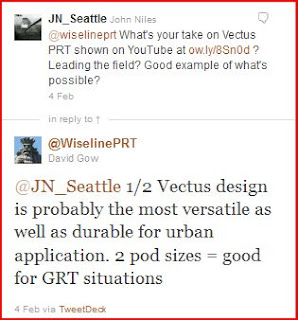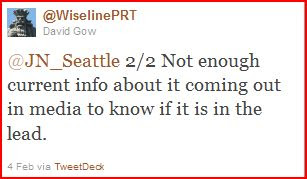Yesterday I answered a tweeted question from @JN_Seattle ("John Niles") about Vectus PRT:


Pretty straightforward.
Yet this a.m. the Laffable Luddite ignores the question marks in Niles's tweet, and jumps to the conclusion:
Which is a good example of the basis of the Hail Mary (Business Plan, Jan. 21, 2012): Ken Avidor needs the reader to NOT click the link, read the referenced tweet, and learn that Niles is just asking me questions, and reveals nothing about his position on pod transit.
The only ways Ken can know Niles's position on pods is -- a) ask him or b) read his mind. We know he hasn't asked him.
The actual purpose of Ken's tweet is a Hidden Ball (ibid): he is repeating his phony linkage of PRT with the Discovery Institute (Today's Provocation, Apr. 15, 2006).
The Deconstruction
1. I don't know John Niles except by reputation. He worked at the Cascadia Center, the Urban Issues think tank housed at Discovery.
2. Wacky Discovery promotes Intelligent Design; wonky Cascadia promotes high speed rail, commuter & DMU rail, Portland-style streetcars, and plug-in cars.
Where Discovery is The Munsters, Cascadia is Marilyn.*
3. We can make an educated guess about Niles: he is either conservative or doesn't care a whit about politics. Political contributions by him in federal or Washington state elections are: zero.
Today Niles is working on an EV-based project at CATES, another Puget Sound-area think tank -- hardly what a drill-now/drill-here Republican would do. And the number of writings on the Web by John Niles on subjects not related to transportation politics is exactly: zero, plus or minus zero.
4. Niles's position on light rail is well known. He's been openly against it, based on the size of the investment and operating subsidy. This can be researched at his website, Global Telematics. Instead, he is for Bus Rapid Transit.
On these stands we part company, since I believe the public nature of transit means The People ought to be able to authorize and subsidize anything it wants, if an electoral majority decides it is worthwhile. And readers of This Week In Precipitation know my distaste for BRT.
5. Niles's only connection with PRT is that his site archives papers written in the 1990s by then-State Rep. Dick Nelson (D-Seattle, an engineering PhD) and Berkeley economist Don Shakow, funded in part by the Bullitt and Medina foundations (extremely reputable Seattle foundations). Nelson and Shakow mention PRT along with a host of noncontroversial proposals.
Ken will say this is enough of a connection. But that 1990s activity did not arise from a vacuum. The concurrent Raytheon PRT program had created expectation of availability of a PRT system to act as a circulator-feeder for light rail. So much so that Sound Transit nee RTA brought PRT under its umbrella, culminating in a $30 million Innovation Fund which, among other things, was to conduct a PRT demonstration. This is the landscape in which the Nelson-Shakow work took place.
6. It is true that Cascadia, and therefore Discovery, sponsored a 2005 public workshop in which PRT was discussed (no policy statements resulted). But if that makes Niles a 'pod person,' then he is also a commuter rail person and a passenger ferry person, since those were the subjects of other meetings in the series. Hardly disreputable.
Conclusions
ALSO TODAY:
Feb. 4: Nathan Koren states his opinion (see first Feb. 4 post) that bureaucracies plan and purchase transit systems without much regard for public input.
Feb. 5: Ken Avidor claims Koren dismisses the importance of public involvement in decision-making.
gPRT
* I suppose I have to note that I would not date Marilyn, lest Ken try to imply something.





No comments:
Post a Comment